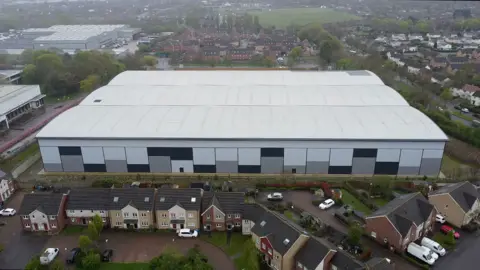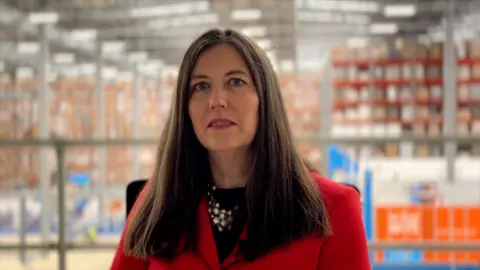Why are people living in the shadow of 'mega-sheds'?
 Dawid Wojtowicz/BBC
Dawid Wojtowicz/BBCBang in the middle of England, Northamptonshire has more storage and distribution centres than anywhere else in the country.
Corby, for example, is home to dozens of towering "mega-sheds", including Europa's worldwide HQ and Nike's forthcoming logistics campus.
But real estate experts say the current crop is just the start, and the UK will need the equivalent of more than 2,000 football pitches of extra warehouse space to keep up with house-building targets and the growth of online retail.
The head of the UK Warehousing Association insisted warehouses were an "important engine of growth" and said several recent constructions near to people's home were the result of a "broken planning system".
Speak to people in Corby town centre about warehouses and a theme soon emerges.
"I think they're disgusting," one woman said, "an eyesore - I know we need them, but people have got their houses right next door."
"We've got enough now" another woman tells me, "put them somewhere else."
That may be wishful thinking.
 Dawid Wojtowicz/BBC
Dawid Wojtowicz/BBCWill Laing, a research analyst at Newmark Group, a specialist in commercial real estate, said warehouses in Northamptonshire are likely to keep getting bigger, as occupiers seek to expand and improve performance.
"We are seeing trade flows from the Port of Felixstowe in Suffolk increase significantly, and these trade flows naturally go into the golden logistics triangle (an area of the East Midlands).
"Having a larger warehouse there allows for occupiers to reach the vast majority of consumers, and provides a central base for their other logistics networks."
More homes mean more warehouses on the horizon, he said.
"On average, 69 sq ft (6.4 sq m) of warehouse space is needed to service each new home," said Mr Laing.
"Given the government's target to build 1.5 million homes in the next five years, coupled with the continued shift to online retail, we estimate 150,000,000 sq ft (13,935,456 sq m) of extra warehousing will be needed over the next 10 years."
That's the equivalent of 2,160 football pitches, or about 1,500 large warehouses measuring 100,000 sq ft (9,290 sq m).
 Chetwoods/Nike
Chetwoods/NikeThe warehouse-dotted landscape in Northamptonshire has provoked anger from some communities.
There have been thousands of objections to a proposed distribution site on farmland near Thrapston and a recently approved DHL logistics hub on the outskirts of Towcester.
Elsewhere, in Corby, those opposed to living in the shadow of an 18m (59ft) warehouse on the site of the former Weetabix plant were recently refused a judicial review.
However, a judge said the council had "fallen well below the standard expected" by failing to consult residents properly after distributing notices to the wrong street.
The warehouse in question, Rockingham 161, is currently vacant and taking bids from occupiers with the promise of bringing hundreds of jobs to the local area.
It's a similar story for villagers in Nacton near Ipswich, who told the BBC a "mega-shed" near their homes, the size of six football pitches, had brought them to tears.
Neighbours have described the warehouse as a "monstrosity" and "the wrong development, in the wrong location".

But not everyone agrees warehouses are an eyesore.
"I love them" says Clare Bottle, chief executive of the UK Warehousing Association.
"If I had one at the bottom of my garden, I would genuinely not be disappointed, because I think they look majestic and wonderful.
"But there is a bigger story here, because poorly located warehouses are a symptom of our broken planning system.
"Those areas with warehouses near homes in Corby and Nacton have been nominated as industrial land, so it's easier to get planning permission, and we're finding in East Anglia there just isn't enough industrial land."
However, that could soon change under government reforms to planning policy, which are the subject of a public consultation.
The measures would allow more areas of the green belt to be defined as grey belt, making them suitable for commercial development.
Ministers insist logistics is one of the key industries the reforms will aim to support.
"We're not building warehouses for the sake of it," Mrs Bottle said. "We're building them because they're an important engine of growth in our supply chains these days, and that's good for everyone.
"We're more reliant on the service sector than ever before, and we're relying on goods being as close to the supply chain as possible."
Despite public objections to more warehousing, the industry has been growing largely due to a shift in people's spending habits.
Official figures show internet sales as a percentage of total retail has risen steadily over the past 20 years and now stands at about 27%, with consumers expecting ever quicker deliveries or returns.
Clare Newton, commercial director at Warehouse Space, a storage rental service, says people need to get used to warehouses.
"What human beings have got to appreciate is if they're buying stuff online and want it tomorrow, then guess what, it's going to a warehouse near you.
"Eight per cent of the UK population is employed in logistics, and all of them are running around to make people's lives cheaper and easier."
